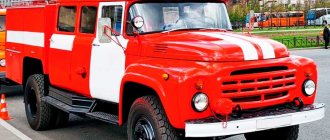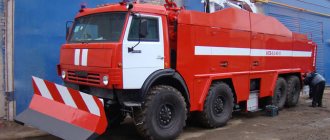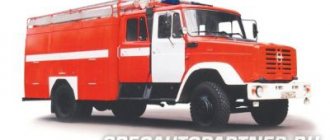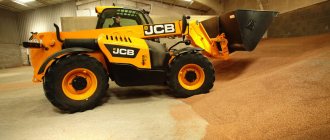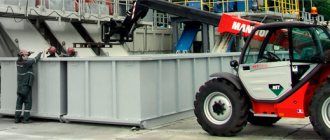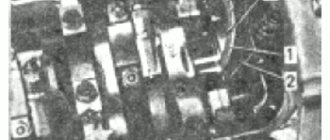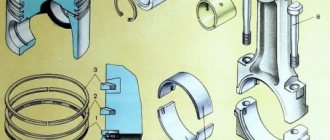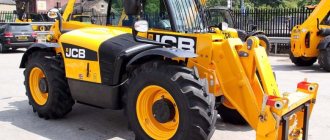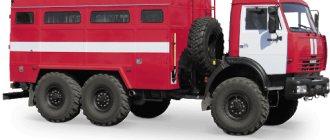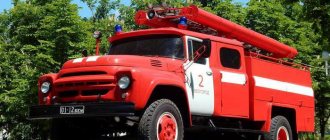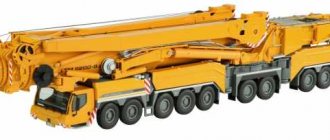Auto hydraulic lifts
The AKP-50 fire truck based on the chassis of the KamAZ-6540 vehicle is designed to deliver combat crews and fire-fighting equipment to the site of rescue and fire-fighting operations, carry out rescue operations at a height of up to 50 m, supply fire extinguishing agent to a height of up to 50 m and carrying out rescue operations at the fire site. Operation of the aerial platform is possible at ambient temperatures from - 40 to + 40 degrees Celsius and wind speeds of no more than 10 m/s.
Equipment of the AKP-50 fire truck:
- bag - 1 pc.;
- pickaxe - 2 pcs.;
- key 80 - 2 pcs.;
- anemometer - 1 pc.;
- ladder LP - 1 pc.;
- ice ax crowbar - 2 pcs.;
- tow rope - 1 pc.;
- bayonet shovel - 2 pcs.;
- heavy LPT scrap - 2 pcs.;
- carpenter's ax - 1 pc.;
- cable cutter - 1 pc.;
- fire extinguisher OU-3 - 1 pc.;
- generator GPS-600 - 2 pcs.;
- comb for GPS-600 - 1 pc.;
- car first aid kit - 1 pc.;
- dielectric carpet - 1 pc.;
- dielectric boots - 1 pair;
- universal health care facility scrap - 1 pc.;
- anti-recoil block - 2 pcs.;
- pads for outriggers - 4 pcs.;
- warning triangle - 1 pc.;
- fire assault ax - 1 pc.;
- dielectric gloves - 1 pair;
- fire rescue belt - 2 pcs.;
- dielectric scissors ND-1 - 1 pc.;
- all-metal hook BPM - 1 pc.;
- three-way branching RT-80 - 1 pc.;
- connecting head GP-70x50 - 2 pcs.;
- connecting head GP-80x70 - 2 pcs.;
- removable monitor barrel LSD-S20U - 1 pc.;
- set of keys for car repairs - 1 set;
- knife (seat belt cutter) - 1 pc.;
- special loudspeaking device SGU - 1 pc.;
- winch with hook and cable 25 m long - 1 set;
- manual combined barrel Dy70, RSKZ-70 - 1 pc.;
- special tools and accessories - 1 set;
- device for attaching a rescue hose - 1 pc.;
- fire rescue rope VPS-50 (30 m) in a case - 1 pc.;
- electric flashlight FPS-4/6 with charger - 2 pcs.;
- fire rescue rope VPS-30, (30 m) in a case - 1 pc.;
- fire rope release device “Standard” L=50m - 2 pcs.;
- manual combined overlapping barrel Dy70, RSP-70 - 1 pc.;
- pressure connecting hose with fittings d.77mm, L=20m - 4 pcs.;
- pressure connecting hose with fittings d.66mm, L=20m - 2 pcs.;
- sectional rescue hose with fastening unit RS-S-49 - 1 pc.;
- pneumatic jump rescue device PPSU-20 - 1 pc.
| Technical characteristics of the AKP-50 fire aerial platform | |
| Lifting height / lowering depth, m | 50 / 6 |
| Loading capacity of the cradle, kg | 400 |
| Angle of rotation of the cradle, o | ± 30 |
| Maximum reach, m | 19 |
| Boom rotation angle, o | is not limited |
| Time for raising the cradle to the greatest height / lowering to the ground, sec. | 220 / 200 |
| Support contour dimensions, mm | 4,800 x 5,400 |
| Chassis | KamAZ-6540 |
| Engine | diesel |
| Engine power, kW (hp) | 191 (260) |
| Maximum speed, km/h | 85 |
| Number of seats for combat crew | 3 |
| Total weight, kg | 29 000 |
| Overall dimensions, mm | 12,000 x 2,500 x 3,800 |
Models of aerial platforms with similar characteristics:
- Fire truck AKP-50 - MZKT-6923
- Fire truck AKP-50 – TATRA-T815
Device
All types of firefighting vehicle lifts (see above) have the same design:
Types of firefighting vehicle lifts
1 – chassis; 2 – supports; 3 – spring locking mechanism; 4 – rotating frame; 5 – knee lift mechanism; 6 – set of knees; 7 – cradle
a – with articulated knees; b – with telescopic knee connection; c – with articulated-telescopic knee joint
In the future, the option with a telescopic connection of the knees will be considered.
The booms and cradle are controlled by hydraulic cylinders.
Basic kinematic diagram of lifting and extending the cradle
1 – hydraulic cylinder for lifting the boom kit; 2 – rotation mechanism; 3 – rotating frame; 4 – telescopic boom; 5 – hydraulic cylinder for leveling the cradle; 6 – cradle; 7 – articulated boom; 8 – hydraulic cylinder for lifting the articulated boom; 9, 10 – levers
Hydraulic cylinder 1 (there are two of them on the agro-industrial complex) with dimensions 160×110×1200 mm (piston diameter, rod, piston stroke) provides lifting of a set of booms: telescopic 4 and articulated 7. Hydraulic cylinder 8 (160×110×1440 mm) for lifting the articulated boom 7 provides levers 9 and 10 for lifting it by 180°. On each boom 7 there is a hydraulic cylinder 5 for leveling the cradle 6. This is carried out by a special leveling control unit (BUG).
The cradle with a load capacity of 300 kg accommodates 4 people. It is rotated by a special hydraulic cylinder to turn right and left by 45°.
Fire monitors are usually installed in the cradles, or places for their attachment are equipped. The barrel can be rotated left and right by 50°, and up and down by 65° and 40°, respectively.
Water is supplied to the fire monitor through special water conduits of a telescopic device located inside the booms, which have a box-shaped rectangular cross-section.
The cradle is equipped with a device that limits the load capacity.
The cradle has a control panel.
Scheme for extending telescopic sections
1 – first section; 2, 14 – slider; 3 – tensioner; 4 – second section; 5, 8, 9, 15, 16 – rollers; 6 – telescope base; 7 – shift chain; 10 – traction; 11 – rod; 12 – hydraulic cylinder; 13 – extension chain
Telescopic boom 4 consists of three sections placed one inside the other.
All sections of the telescopic boom move relative to each other on rollers and slides. The rod 11 of the hydraulic cylinder 12 is fixed to the end of the base of the telescope 6, and the hydraulic cylinder 12 moves freely, resting with the slider 14 on the surface of the first section 1. When extended, the hydraulic cylinder 12 moves to the left and pulls out the second section, rigidly connected to the hydraulic cylinder. At the same time, the first section is pulled out by chain 13. The first section 1 is pulled out through the roller 5 using a chain 13. One end of the chain is attached to the first section, and the second is secured to the end of the base of the telescope 6 by means of a rod 10.
When the sections are shifted, the hydraulic cylinder 2 moves to the right, retracts the second section 4. At the same time, through the roller 9 with a chain 7 connected to the first section, the entire system will be pulled into the base of the telescope 6. The tension of the chain 7 is carried out by the tensioner 3.
Design features
Firefighting aerial lifts, like aerial ladders, have a fixed and rotating part. The non-rotating parts and rotation mechanisms of AL and APK are identical. Their main difference lies in the design of the cradle extension mechanisms.
The main mechanisms and units of car lifts are:
- base chassis;
- platform with supporting structures for the transport position of the boom;
- power group;
- hydraulic system;
- a support device including a frame, hydraulic outriggers;
- lifting and rotating part, consisting of a rotating tower, lifting booms and a cradle;
- built-in water and foam communications;
- mechanism for deploying booms, turning the turret and turning the cradle around a vertical axis;
- electrical equipment with locking and alarm system;
- controls.
Maintenance and inspection
On this topic ▼
Maintenance and repair of fire trucks
Types, procedure, timing
Ensuring the readiness and reliability of firefighting aerial lifts. For the effective use of automatic transmission or AL, maintenance and technical examination .
Maintenance includes all types of ongoing maintenance, as for fire ladders. The list of works is regulated by factory instructions.
Technical examination. Technical examination is carried out in order to ensure reliable operation of all automatic transmission mechanisms. The operation of all automation, blocking and alarm devices is checked along the entire border of the cradle's movement field, called the reach zone. Technical inspection is carried out by the owner. There are two types of technical examination:
- Partial – at least once a year.
- Complete – at least once every three years.
In addition, the load limiter is tested at least once every 6 months.
The working field (reach zone) is the area outlined by the top of the boom (the outer edge of the cradle) when maneuvering it with the maximum permissible reach and height for the corresponding lifting capacity. Thus, it includes the safe operating area of a fully loaded cradle, covering the lift height and boom reach. The zone is set by the manufacturer.
Working field of a firefighting vehicle lift using the example of AKP-32(4310)
During a partial technical examination, the following is carried out:
- external inspection (during an external inspection, the condition of the automatic transmission as a whole, its mechanisms, structural elements, and electrical wiring is checked;
- checking the operation of automation, blocking and alarm devices;
- dynamic tests.
A complete extraordinary technical examination is carried out in case of replacement of design elements and assembly units, as well as after a major overhaul of the automatic transmission.
Full technical examination includes:
- visual inspection;
- no-load test;
- checking the operation of automation, blocking and alarm devices;
- static and dynamic tests.
Standard sizes
Firefighting car lifts, depending on the maximum working height of a fully unfolded car lift, should be manufactured in the following standard sizes:
| Standard size | Lifting height of the cradle, m |
| APK 10-15 | 10-15 |
| APK 16-21 | 16-21 |
| APK 22-28 | 22-28 |
| APK 29-36 | 29-36 |
| APK 37-48 | 37-48 |
| APK 49-56 | 49-56 |
| APK 56-64 | 56-64 |
At the customer's request, it is allowed to manufacture a firefighting aerial lift with a working height of more than 64 m with parameters according to the technical conditions for a firefighting aerial lift of a specific standard size.
Sources
- GOST R 53247-2009 “Fire fighting equipment. Fire trucks. Classification, types and designations."
- M.D. Bezborodko, Textbook Fire Engineering
, Moscow, 2004 - Presnov A.I., Kamentsev A.Ya., Ivanov A.G. and others. Fire trucks: A textbook for a fire truck driver. - St. Petersburg, 2006.-507 p.
- Initial training of firefighters, fire equipment: Educational and methodological manual. — Barnaul, 2002
- Order of the Ministry of Emergency Situations of Russia dated September 18, 2012 No. 555 On the organization of material and technical support for the system of the Ministry of the Russian Federation for Civil Defense, Emergencies and Disaster Relief
The highest fire truck lift
On this topic ▼
Car lift Bronto Skylift F 112 HLA
Description and performance characteristics
The Finnish company Bronto holds the height record for telescopic car lifts. Their telescopic car lift, Bronto Skylift F 112 HLA, is capable of lifting firefighters to a height of 112 meters. The record is that the platform can be at a height of 90 meters with the boom extending 25 meters outwards.
The mechanism is mounted on a standard Mercedes-Benz Actros 7660 chassis, modified into a seven-axle vehicle by Paul Nutzfahrzeuge. Five axles of the unusual chassis are steerable, and four are driven. In the transport position, the car lift has a height of 4 m and a length of 19 m, which allows movement on public roads. The curb weight of the “champion” reaches 77,000 kg.
Transmission
Previously, KamAZ-6540 dump trucks and four-axle chassis based on them were equipped with KamAZ-154 gearboxes. This is a mechanical, three-way, ten-speed gearbox, which consists of a main five-speed gearbox and a two-stage divider located in front of the main gearbox. The gears are equipped with synchronizers.
Subsequently (since 2010), it was replaced by nine-speed manual transmissions ZF 9S1310, and then ZF 9S1315 (currently installed). The ZF 9S gearbox consists of a four-speed unit with reduction gear and reverse gear, with an intermediate shaft. The number of these gears is doubled thanks to the use of a rear-mounted planetary type multiplier. Thus, together with the reduction gear, a total of nine gears are obtained for forward travel. Gears from 1st to 4th belong to the lowest range, and gears from 5th to 8th belong to the highest range of the multiplier. The gearbox is equipped with a backup steering pump driven by the drive wheels, which ensures the operation of the power steering in the event of failure of the main power steering pump.
Both types of these manual transmissions are connected to the engine using a single-plate diaphragm clutch with a hydraulic drive (with pneumatic booster). The final drive ratio is 7.22 or 5.94.
Designation and marking
The designation of a firefighting vehicle lift has the following structure:
AKP-32 (43118) mod. XHA-XX XX X,
Where:
- AKP / TPL – fireman's articulated car lift or fireman's telescopic car lift with a ladder, respectively;
- 32 – lifting height 32 meters;
- (43118) – index of the base chassis model according to the automotive industry classification (in this case, KamAZ-43118);
- Maud. ХХА – designation of the fire ladder model according to the developer’s system, indicating the modernization (A – first, B – second, etc.);
- XX – two-digit (three-digit) digital index to designate the model (01, 02, etc.);
- XX – conventional letter designation of the manufacturer;
- X – designation of a regulatory document (GOST, TU).
| Symbol of agro-industrial complex on fire extinguishing diagrams | Symbol of TPL on fire extinguishing diagrams |
Cabin KamAZ-6540
From 2001 to 2010, KamAZ four-axle vehicles were equipped with old-style cabs. These cabs were put on the assembly line back in the 1970s and even broke the record for production duration (held by the GAZ-51 cabs, which were produced for twenty-nine years). There have been modernizations of KamAZ cabs, and more than once. However, most often the changes in the design turned out to be so insignificant that the results were little or not noticeable to a wide range of motorists.
Until 2010.
There have been talks about equipping Kama trucks with fundamentally new cabs for more than ten years. The bet was made on acquiring a license for a discontinued cab of the previous generation of trucks from one of the European brands.
DAF and MAN were considered (we agreed on the purchase of the cabin of the previous generation of TGA trucks). As a result, an agreement was concluded with Daimler for the assembly production of Mercedes Actros (and then Axor) truck cabins. This was no longer just one long-range cab for long-haul tractors, which had previously been demonstrated in a “varnished form”, but a whole range of cabs, allowing KamAZ to complete the modernization of trucks of all models.
In the cabin of a KamAZ dump truck after restyling.
There was very little comfort in the old-style cabin by modern standards. She is tough, shaking, noisy. But it’s warm enough: drivers of “pre-reform” KamAZ trucks working in regions such as Yamal and the Khanty-Mansiysk Autonomous Okrug will not let you lie.
In terms of comfort and ergonomics, the new air-suspension cab is not comparable to the usual classic KamAZ one. The interior here is also in perfect order: it is in no way inferior to that of a Mercedes. There is no sleeping space, which is a traditional solution for serial dump trucks.
